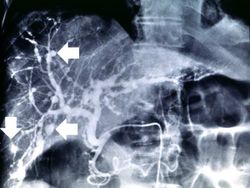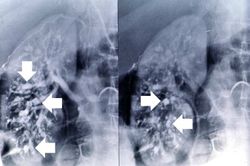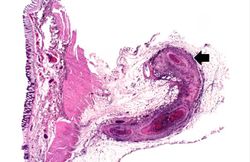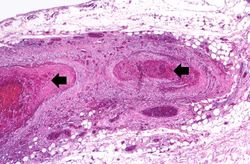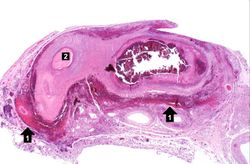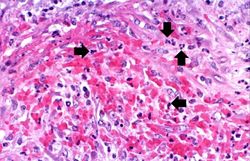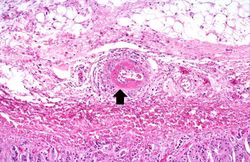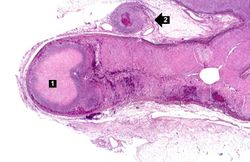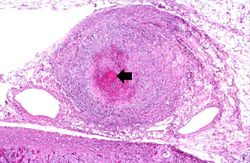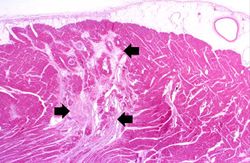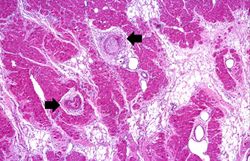Difference between revisions of "IPLab:Lab 6:PAN"
(Created page with "== Images == <gallery heights="250px" widths="250px"> File:IPLab6PAN1.jpg| File:IPLab6PAN2.jpg| File:IPLab6PAN3.jpg| File:IPLab6PAN4.jpg| File:IPLab6PAN5.jpg| File:IPLab6PAN6....") |
|||
| Line 1: | Line 1: | ||
== Images == | == Images == | ||
<gallery heights="250px" widths="250px"> | <gallery heights="250px" widths="250px"> | ||
| − | File:IPLab6PAN1.jpg| | + | File:IPLab6PAN1.jpg|This angiogram of the abdominal viscera demonstrates numerous aneurysms throughout the mesenteric circulation (arrows). |
| − | File:IPLab6PAN2.jpg| | + | File:IPLab6PAN2.jpg|This angiogram of the liver also demonstrates numerous aneurysms throughout the hepatic circulation (arrows). |
| − | File:IPLab6PAN3.jpg| | + | File:IPLab6PAN3.jpg|This angiogram of the kidneys demonstrates numerous aneurysmal dilatations in the renal circulation (arrows). |
| − | File:IPLab6PAN4.jpg| | + | File:IPLab6PAN4.jpg|This is a low-power photomicrograph of a mesenteric vessel from this case of polyarteritis nodosa (arrow). The vessel is completely occluded by thrombotic material and the vessel wall is infiltrated with inflammatory cells. |
| − | File:IPLab6PAN5.jpg| | + | File:IPLab6PAN5.jpg|This is a higher-power photomicrograph of this mesenteric vessel. Note the thrombotic material occluding the vessel (arrows) and the inflammatory cell infiltrate in the wall of the vessel and in the surrounding adventitia. |
| − | File:IPLab6PAN6.jpg| | + | File:IPLab6PAN6.jpg|his is another example of a mesenteric artery from this case. There is a marked inflammatory cell response surrounding this vessel, fresh hemorrhage (1), and thrombotic material (2). |
| − | File:IPLab6PAN7.jpg| | + | File:IPLab6PAN7.jpg|This is a high-power photomicrograph of the vessel wall. There is hemorrhage and infiltration with inflammatory cells--primarily neutrophils (arrows). |
| − | File:IPLab6PAN8.jpg| | + | File:IPLab6PAN8.jpg|This is a high-power photomicrograph of a small vessel with a rim of fibrinoid necrosis (arrow). |
| − | File:IPLab6PAN9.jpg| | + | File:IPLab6PAN9.jpg|This is a low-power photomicrograph of the adrenal gland. There is an area of necrosis in the adrenal (1) and an affected vessel adjacent to the adrenal (2). |
| − | File:IPLab6PAN10.jpg| | + | File:IPLab6PAN10.jpg|This is a higher-power photomicrograph of the affected vessel from the previous image. The vessel wall is infiltrated with inflammatory cells and the vessel lumen is completely occluded (arrow). |
| − | File:IPLab6PAN11.jpg| | + | File:IPLab6PAN11.jpg|This is a low-power photomicrograph of the heart. There are areas of fibrosis in the myocardium (arrows). Note that the large epicardial coronary artery is normal. |
| − | File:IPLab6PAN12.jpg| | + | File:IPLab6PAN12.jpg|This is a higher-power photomicrograph of the affected vessels in the heart (arrows). There are areas of fibrosis (old infarcts) in the myocardium adjacent to these affected vessels. |
| − | File:IPLab6PAN13.jpg| | + | File:IPLab6PAN13.jpg|This is a high-power photomicrograph of the affected vessel in the heart. The vessel lumen is completely occluded. |
</gallery> | </gallery> | ||
Revision as of 18:00, 20 August 2013
Images[edit]
An infiltrate is an accumulation of cells in the lung parenchyma--this is a sign of pneumonia.

